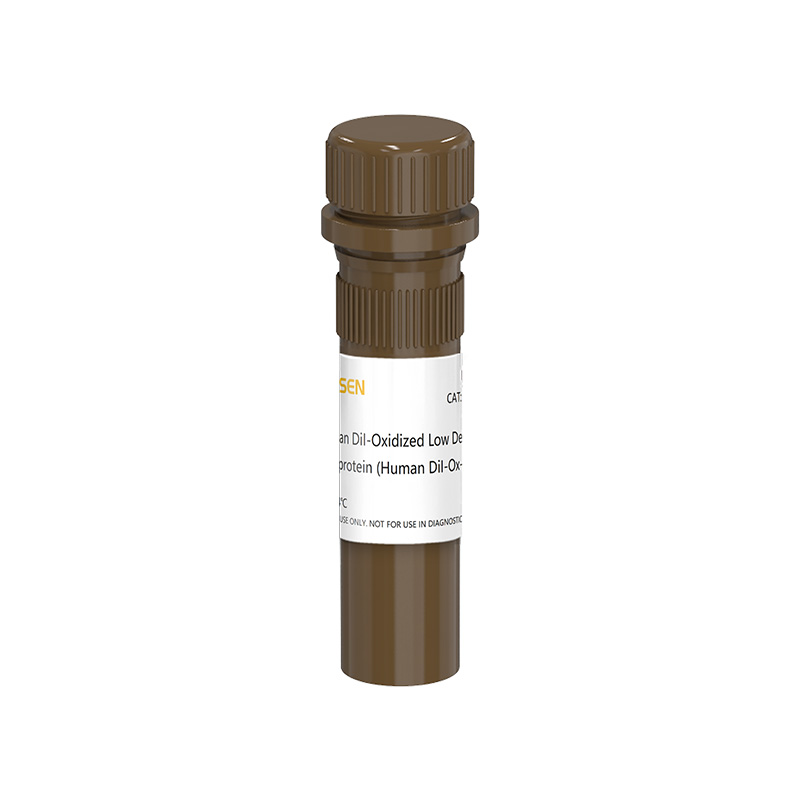Human DiI-Oxidized Low Density Lipoprotein (Human DiI-Ox-LDL)
Product Description
Low Density Lipoprotein, or LDL, is converted from very Low Density Lipoprotein (VLDL). Its main function is to transport cholesterol to cells throughout the body. Cholesterol is transported to the liver for synthesis of cholic acid. It can be used to study receptor - mediated endocytosis. Plasma derived LDL can be used to study the oxidative role of LDL in function and metabolism, especially in diseases such as atherosclerosis.
Acetylated LDL is a class of modified LDL. LDL contains the unmodified apolipoprotein and can be used to study the transport and endocytosis of normal cholesterol. When the lysine residue of LDL apolipoprotein is acetylated, the LDL complex no longer binds to the LDL receptor. However, modified LDL is more likely to bind to "Scavenger" receptors in endothelial cells and microglial nerve cells. Therefore, AC-LDL can be used to study the function of these cells.
Acetylated LDL from healthy human plasma, tested negative for Hepatitis C, HIV-I and HIV-II antibodies. This product is sterile packaging and can be directly diluted for use.
This product is a red fluorescent labeled acetylated human low density lipoprotein, which is Ox-LDL labeled with fluorescent probe DiI (1,1'-dioctadecyl-3,3,3',3' -tetramethyl-indocarbocyanine perchlorate). Vascular endothelial cells and macrophages can be labeled to identify and select these cells, and to study the endocytosis of different cell lines on modified LDL. Each lot of DiI-Ox-LDL supplied by our company was tested for labeling specificity of bovine aorta endothelial cells and mouse macrophages to ensure consistency of results.
Human DiI-Ox-LDL supplied by YEASEN comes in aseptic packaging and can be directly diluted for use. In addition to DiI-Ox-LDL, we also offer Ox-LDL without labeling, AC-LDL (acetylation modification) and unmodified LDL, etc.
Product Properties
|
Concentration |
0.8-3.0 mg/mL |
|
Appearance |
liliquoid |
|
Buffer Components |
0.02 mM EDTA in PBS, pH 7.4 |
Shipping and Storage
The products are shipped with ice pack and can be stored at 4℃ and away from light for 6 weeks.
Do not freeze! Be sure to use aseptic operation!
Cautions
1. The dilution liquid of this product is very unstable, so it is recommended to use it immediately.
2. The product will see a small amount of precipitation after long-term preservation, which is a normal phenomenon. Centrifuge at low speed for 2 min to remove the precipitate and obtain the clarification solution.
3. The binding of LDL to LDL receptor requires the participation of Ca2+ and Mn2+, and the presence of excessive EDTA will inhibit the binding.
4. For your safety and health, please wear lab coats and disposable gloves for operation.
5. For research use only.
Instructions
1.Under sterile conditions, Human DiI-Ox-LDL was diluted to 20-40 µg/mL in cell culture medium.
2.Add into living cells and culture at 37℃ for 3-6 hours.
3.At the end of incubation, the medium containing Human DiI-Ox-LDL was sucked out and washed several times with the medium without probe.
4.Fluorescence microscopy or flow cytometry was used for detection according to experimental requirements.
① Fluorescence microscope observation
Standard rhodamine excitation: emission filter (or suggested wavelength: Ex/Em=549 nm/565 nm); If necessary, please use PBS containing 3% formaldehyde for fixation, do not use methanol or acetone for fixation, because Dil is easily soluble in organic solvents. [Note] Positive cells should be set as control.
② Cell sorting (flow cytometry)
The cells were treated with trypsin or made into a single cell suspension by adding EDTA. Suitable labeled purified cells were selected as negative and positive controls for flow sorting (GATE). (Recommended wavelength Ex:514/549 nm; Em: 565 nm).
[1] Zhang L, Xue S, Ren F, et al. An atherosclerotic plaque-targeted single-chain antibody for MR/NIR-II imaging of atherosclerosis and anti-atherosclerosis therapy. J Nanobiotechnology. 2021;19(1):296. Published 2021 Sep 28. doi:10.1186/s12951-021-01047-4(IF:10.435)
[2] Wang D, Cheng X, Li Y, et al. C/EBPδ-Slug-Lox1 axis promotes metastasis of lung adenocarcinoma via oxLDL uptake. Oncogene. 2020;39(4):833-848. doi:10.1038/s41388-019-1015-z(IF:6.634)
[3] Tao J, Qiu J, Lu L, et al. ZBTB20 Positively Regulates Oxidative Stress, Mitochondrial Fission, and Inflammatory Responses of ox-LDL-Induced Macrophages in Atherosclerosis. Oxid Med Cell Longev. 2021;2021:5590855. Published 2021 Mar 9. doi:10.1155/2021/5590855(IF:6.543)
[4] Zhang Y, Xu X, Ma J, et al. Loss of CD226 protects apolipoprotein E-deficient mice from diet-induced atherosclerosis. Biochim Biophys Acta Mol Basis Dis. 2022;1868(9):166452. doi:10.1016/j.bbadis.2022.166452(IF:5.187)
Catalog No.:*
Name*
phone Number:*
Lot:*
Email*
Country:*
Company/Institute:*

